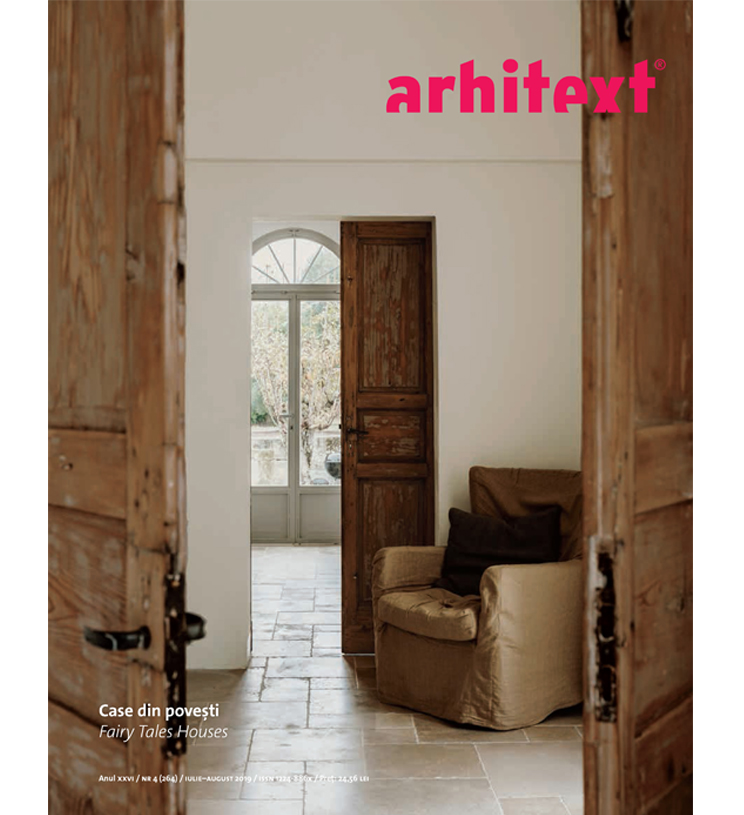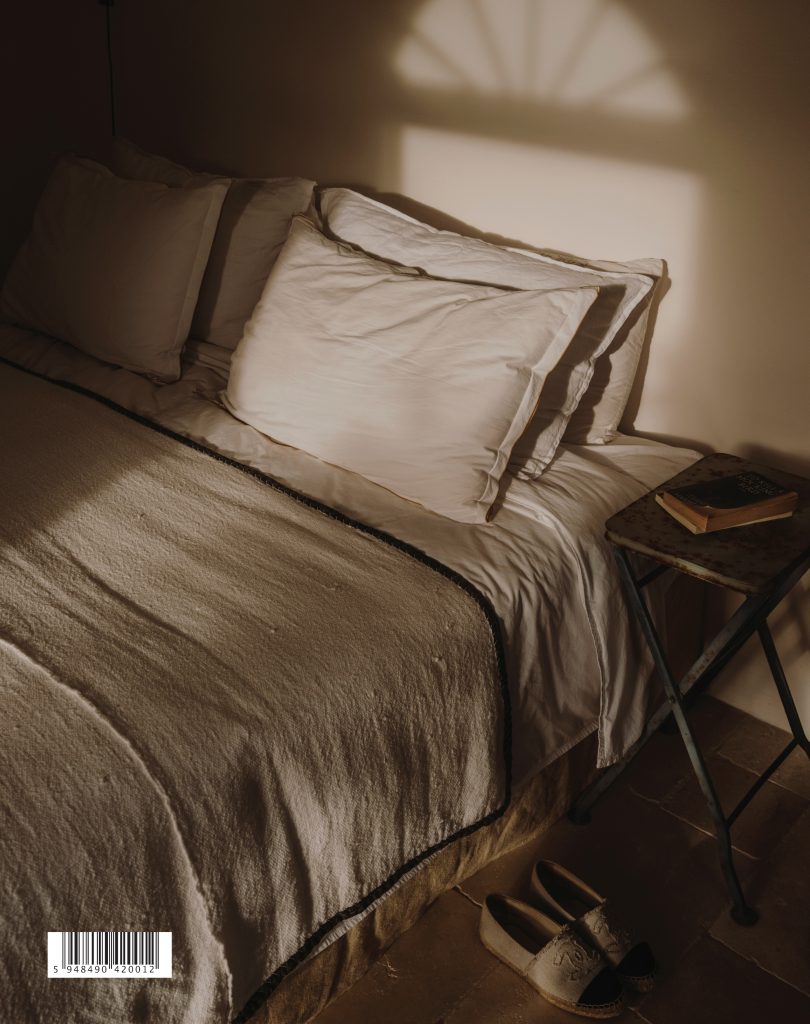Arhitext 4/2019 – Fairy Tales House
Arhitext 4/2019 - Contents

6 Bucharest Triennale East Centric Architecture – 3rd Edition
Interview Cătălina Frâncu – Flores & Prats
Another thing that characterizes our architectural approach is our interest in building communities, not only community between neighbours, but also a feeling of community between the people who visit our building. In the case of Sala Beckett, the community exists not only in space, but also in time. This one is of higher complexity, because one has to establish a relationship between elements that left a mark, but are not present anymore.
On the other hand, in Building 111, we were presented with a number of people who have no history together. Thus the central void we designed has the purpose of binding them together through random or intentional encounters; we would say it is a platform of social relationships.
Ricardo Flores
recenzie
12 Iulia Stanciu
Atmosfere de Peter Zumthor
workshop
14 A locui. A treia cameră

The sea shore at Naoshima, Japan, Photo: Cristina Ene
DE JUR ÎMPREJUR
16 Mihai Pienescu
Flesh and Blood
UAUIM
18 Departamentul Sinteza Proiectării de Arhitectură – Proiectele anului IV – Semestrul 1, semestrul 2
21 Departamentul Sinteza Proiectării de Arhitectură – Proiectele anului V – Semestrul 1, semestrul 2
28 URBAN CATALYST – SULINA 2050
30 ABSENT SPACES / ABSENT PROGRAMS
32 Departamentul «Istoria & Teoria Arhitecturii și Conservarea Patrimoniului»
THEORY
Fairy Tales Houses
34 Arpad Zachi
The First Story: The Nostalgy for Something You Didn’t Have
The Second Story: «The Companion» from Far Away
The Third Story: «The Conductor» and «The Magician»
48 VINTILĂ MIHĂILESCU
Home. Archeology and Psychoanalysis
Home is, first of all, a «place» cut out of a «space». «I heard about space, too», replied a peasant to Ernest Bernea; but what is space? «In books it’s called space, but we call it place, this is how it’s called». Another one says: «There is a good place and a bad place, each place has his own bearings, like each person. There are places that can hurt you». As for the house, perhaps all «traditional» peasants would have most likely agreed with this statement: «Each house has its own place, like everything else. The house’s place is a good place, a safe one. Whatever you plant here, grows, whatever you do here, is beautiful. This is because of your ancestors’ spirit». To put it in modern cultural terms, home is inscribed into what Marc Augé, in turn, considers to be the «place», in opposition to the «non-places» of malls, airports, corporate offices etc. «If a place can be defined as filled with identity from a relational and historical point of view, a space that has nothing to do with identity and is neither relational, nor historical can be considered a «non-place». Certainly, as a «place», «home» has a history that can be reconstructed through a kind of «house archaeology» and composes an incorporated identity which is accessible through a kind of «psychoanalysis». Briefly put, the social biography of domestic objects is always an autobiography as well: each «archaeology» of an inhabited house that is thorough enough also becomes a «psycho-analytical» process of the profound self. Moreover, body, house, society and cosmogony or ideology all make up a coherent whole more or less explicit in each kind of society, even in our individualist world where we have come to be convinced that a house, our home, is exclusively the work of our personal choices. However, in what follows, I do not intend to go that far into these details.
52 Andreea- Livia Ivanovici
Whom Do You Call Home?

Studio Andrew Trotter, Villa Castelluccio, photographs: Salva Lopez, Marcelo Martinez
62 Studio Andrew Trotter
Villa Castelluccio
66 Mihai Zachi
Fuzzy Nostalgias of (Few and Far Between, Far Away and Far Out) Pieces of (At)Home
86 Livia Ionescu
The Home from the Other Side
To me, Bucharest is absolute. The houses, the streets, what goes on or doesn’t go on in Bucharest – all these things interest me greatly. Bucharest is the main landmark and, for example, I’m not up-to-date only with, say, politics. I read the news about minor things with great care – for example, changing of a bus line. Or the lamentable state of the boulevard, the North-South axis, from Piața Romană to Colțea Boulevard hurts me deeply. It seems to me terribly ugly and has become peripheral. The city center has become marginal. It has become a sort of slum avenue, so unkempt it is, and that makes me suffer. But even this suffering, and the almost repulsive feeling that the city center stirs in me, and especially this ax, shows how much I’m connected to the city – I can’t be indifferent to what goes on in Bucharest. Instead, now, especially in May, when the vegetation is beautiful, it seems to me that Bucharest is not only a city, but also a kind of jungle. Because where I live the trees are cut, they are domesticated. Here you walk on a pavement leaning forward so that leaves and branches don’t fall over your head or hurt your eyes. So, this jungle city is also fascinating. Everywhere… the fact that the vegetation is allowed to grow so savage. I find it remarkable: you can hear so many birds! In such a polluted place, they are allowed to live here.
Ion Vianu

98 Dana Milea
A Different Way of Living
100 Ilinca Pop
E1027: On a Scale from 1 to 10, About How Forgotten Have You Been in the History of Architecture?
112 A.M. Zahariade
To What Extent Can Architecture Be an «Ideological Mirror»?
Is architecture truly able to convey and pass on ideological content over time – or the ideological content that created it? The film «Hotel Jugoslavija» seems to be based on such presumption. It was stated on Saturday and it has been said for some time that architecture is a political act at all times, from the smaller gestures to the greater ones. It may seem a fairly broad generalization, valid, perhaps, insofar as we refer to any act concerning the polis and the politeia. However, such generalization doesn’t lead us far, firstly as the troubling question concerns ideology rather than politics. I will be told: an ideology lies at the foundation of any grand or minor architecture. Certainly, there is a dominant ideology, diffuse and omnipresent in any society, but generally invisible to those who share it, since it refers to the way in which the world is perceived. The study of vernacular architecture provides us with excellent examples on these lines. Yet we find ourselves facing once again a dead-end generalization, and most of all it has nothing to do with political ideology.
Proiecte East Centric
Each project in itself is less important in the following pages. Seen as a whole they tell the story of a neighborhood that could be. A neighborhood for the global citizen.
Everything is wrapped in a black and white, plus gray dominant atmosphere, smooth, leveled, monotonous and a few exceptions, projects that bring some color and some texture. Could we live in the future in such «neighborhoods»?
Andreea-Livia Ivanovici
123 cra-de
REHABILITATION_VL 173

Cra-de, REHABILITATION_VL 173, photographs: Radu Malasincu
126 POOL LEBER ARCHITEKTEN
Living Without a Car
130 VARDAS STUDIO architects + designers
Paphos District Court
132 Cuboid Architekti
Sports Hall in Kuřim
134 IDwhite
Minimalistic Industrial Loft
136 BIRO
Garderoba
140 Ognen Arsov, Ana Kosi, Marko Kavčič
DOKTOR M
142 Marra Group
Margo

 Romană
Romană English
English




